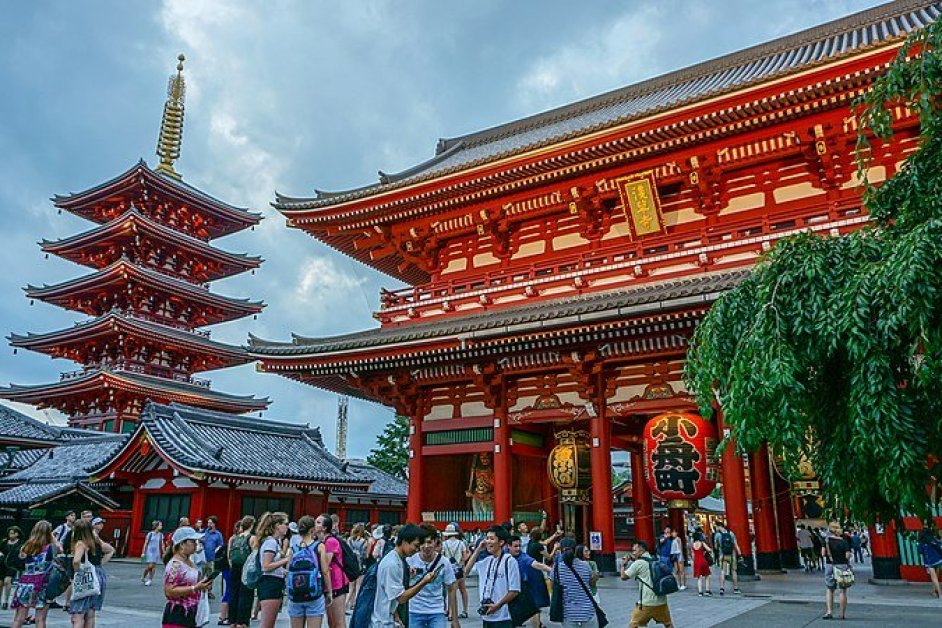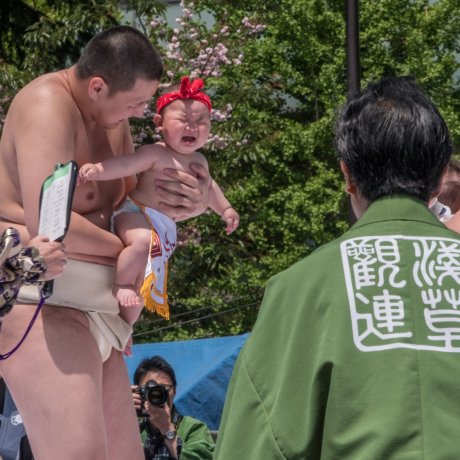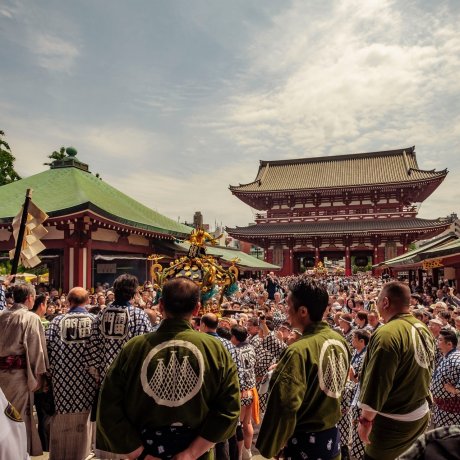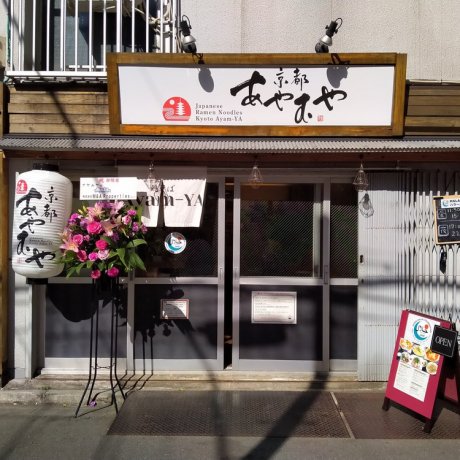
Hatsumode in Asakusa 2026
The first visit to the shrine in the new year is called Hatsumode, and it attracts quite some crowds every year, and I think it..

Senso-ji Temple (浅草寺, Sensōji) is a popular spot for omikuji, or fortunes. These auspicious sheets are offered in a multitude of languages, enticing both Japanese and foreigners alike to see how their luck plays out. If the number you draw is less than lucky, don’t worry – simply tie up the offending fortune on the nearby wires and allow your bad karma to be spirited away.
The temple also shares its grounds with the Asakusa Shrine, dedicated to the three men credited with the temple’s founding. Considered one of the oldest original buildings in Tokyo, the shrine plays host to the exuberant Sanja Matsuri every May. Another popular building (and photo spot) is the five-story pagoda
A number of other festivals take place at Senso-ji throughout the year. The Kinryu-no-mai (Dragon Dance) can be enjoyed on March 18th and October 18th, when a large golden dragon on poles is paraded through the streets. Visitors on April 14th can witness the Sagi-no-mai (White Heron Dance), which features a parade of participants in both Heian-era outfits and heron costumes. In late autumn, the temple’s atmosphere grows even more exuberant during its end of the year rake fairs. Buyers come to purchase one of the many colorfully adorned tools in the hopes of raking in good fortune in the coming year.
It is arguably one of the most popular tourist destinations in the city, Senso-ji Temple – also known as Asakusa Kannon – can trace its roots back to the early 600s. In 628, two fishermen on the nearby Sumida River repeatedly brought up a golden statue of the Buddhist goddess of mercy along with their usual catch. Finally deciding not to throw the statue back to the depths of the river once more, they instead brought it to their village headman, who convinced them to build a temple in its honor. Senso-ji Temple was finished in the year 645 and quickly became a pilgrimage site.
Its popularity endured over the centuries and even continues in the present day, with most visitors making this one of their first stops in Tokyo. The road leading up to the temple, known as the Nakamise-dori or “street of inner shops”, peddles everything from lacquered chopsticks and ukiyo-e prints to cheap keychains and colorful trinkets. Cake-like ningyoyaki¸sweet treats that are served hot off the iron grill, are a popular purchase, as are warming cups of amazake in the winter months.
Nakamise-dori is the street people walk on the approach to Senso-ji. Said to have been born in the 18th century as shop keepers were granted permission to sell their wares along the way to the temple. Today, the 250-meters contains around 90 shops and sells everything from souvenirs to snacks, meals and yukata.
Kaminarimon, literally Thunder Gate, is the outer of two large entrance gates that lead to Senso-ji. The gate houses a large red lantern with a wooden carving of a dragon on the underside as well as two large statues, Fujin (god of wind) on the right and Raijin (god of thunder) on the left.
Hozomon is the inner gate, Kaminarimon being the outer, and houses many of Senso-ji’s treasures. The first story houses two large statures of Nio, the guardian deities of the Buddha; there are also three lanterns and a pair of large sandals.
The impressive five-story pagoda is easily visible as you walk along the path to Senso-ji and worth a visit—and especially worthy of some photographing. It is the second highest pagoda in Japan at 53 meters high and was built in 942 to hold Buddha’s ashes given as a goodwill to Japan from Sri Lanka.
Five-minute walk from Asakusa Station on the Ginza Subway Line, Asakusa Subway Line, and Tobu Railways.

The first visit to the shrine in the new year is called Hatsumode, and it attracts quite some crowds every year, and I think it..

Sensoji is the famous Asakusa Kannon Temple in Taito-ku Tokyo

Nakizumo Crying Baby Festival 2019 in Asakusa's Senso-ji, an unusual but popular festival among parents where babies, carried..
 6
6
The hustle and bustle of a major Japanese temple in Tokyo. Senso-ji is good anytime of the year.
 6
6
Experience a different side of Asakusa at night
 8
8
Sensoji Temple, built in the 7th century, is a Buddhist temple adorned in history and a modern-day Asakusa landmark.

According to a legend, Sensoji was built in 628 on the exact location where two brothers fished the golden statue of Kannon, the..
 17
17
Rituals of Fountain and incense cleasing, and omikuji fortune, in Sensoji Temple
 9
9
Photos from Tokyo's Sensoji Temple in the Asakusa District

Sensoji is a famous buddhist temple in Tokyo, built in the 7th century to house the golden statue of Kannon the goddess of mercy...
 6
6
Senso-ji is an ancient Buddhist temple in Asakusa

Information and photos of the Sensoji Temple in Asakusa, Tokyo.

Sensoji after dark is a completely different world from its daytime hustle-bustle. Walk through avenues of shops shuttered for the..

By far one of Tokyo’s most popular tourist attractions, the Sensō-ji is located in heart of Tokyo: Asakusa.
 6
6
Sensoji Lightup in Asakusa: Quiet and peaceful Sensoji at night
 12
12
Senso-ji is one of the oldest temples in Tokyo. Since the beginning of the Edo era, many people come here. The New Year's holidays..
 12
12
If you come early, before any of the shops open along the long street that leads to the temple from Kaminarimon Gate, you’re i..

Omikuji are written fortunes offered at shrines and temples in Japan. Usually, omikuji require a small offering ( ¥100 usually..

Shirasagi-no Mai is a beautiful ceremonial procession performed at Senso-ji Temple and dates back over 1000 years.

At Senso-ji temple in Tokyo's historical Asakusa district, you can buy traditional decorated bats at the Hagoita-Ichi Fair,..

The first visit to the shrine in the new year is called Hatsumode, and it attracts quite some crowds every year, and I think it..

Sanja Matsuri is one of Tokyo's biggest festivals and features over 100 mikoshi floats paraded through the grounds of Senso-ji..

Northern Tokyo holds a lot of charm with its ever so popular Buddhists temple, Sensoji. Directing you to this stunning temple is..
 9
9
Kaminarimon Gate, standing at the entrance of Sensouji Temple, is Asakura's most famous landmarks.
 12
12
Shiragagi-no-mai, a millennium-old dance in Sensoji Temple in Asakusa

Asakusa is famous for its annual year-end Hagoita (Battledore) Fair held December 17-19. It started in the late 16th century on..
 15
15
During the festival the area around Asakusa's Sensoji Temple is filled with hundreds of people. There are drums and people playing..
 6
6
Five-story Pagoda located near Sensouji Temple in Asakura, Tokyo.
 10
10
Enjoy an Edo Period parade at the Sanja Matsuri held in Asakusa in May
 10
10
Sanja Festival is a jam-packed, three-day celebration in Asakusa that is worth fighting through the crowds for.

Take a glimpse into traditional Japanese culture at the Sanja Festival held annually in Tokyo.

A few suggestions on how to make your day extra smooth at the Asakusa Nakamise shopping street and the famous temple, Senso-ji.


If you're not in the Aomori area during the summer months to experience the Hirosaki Neputa Festival, head to Tokyo's Asakusa..

This December, Tokyo’s historic Sensoji Temple will host Asakusa Culture & Lights, an illumination event combining ancient tra..

NOHGA HOTEL AKIHABARA TOKYO is conveniently located in the midst of the electric town Akihabara, also known as the capital of manga and anime. In addition,..

Oakwood Premier Tokyo comes from a brand of standout luxury hotel & service apartments right at the heart of the Tokyo metropolis. It is located in the..


Ayam-YA is a certified halal ramen restaurant found in the Okachimachi area of Tokyo, between Asakusa and Ueno, and not far from Assalaam Mosque. A sister..
![Moomin House Cafe Tokyo Skytree Town Solamachi [Closed]](http://a1.cdn.japantravel.com/photo/poi-254-212160/460x460!/tokyo-moomin-cafe-tokyo-skytree-town-solamachi-store-212160.jpg)
Enter the world of Moomin, the Finnish fairy-tale comic characters, in the exclusive Moomin Café in Tokyo Skytree Town. This permanent Moomin Café is..

Bunny Cafe Moff Rell in Tokyo's Chiyoda Ward offers a chance to interact with adorable rabbits. You can make reservations for the cafe by phone, or..

The Asakusa Culture Tourist Information Center (浅草文化観光センター, Asakusa bunka kankō sentā) is an eight story building designed by Kengo Kuma. ..

Tokyo Solamachi is a shopping, dining and entertainment complex at the foot of the famous Tokyo Skytree. It has more than 300 shops and restaurants and..

With a height of 634 meters, the Tokyo Skytree is Japan's tallest structure and a symbol of Tokyo. It is located in the northeastern part of Tokyo...
Your feedback has been sent.